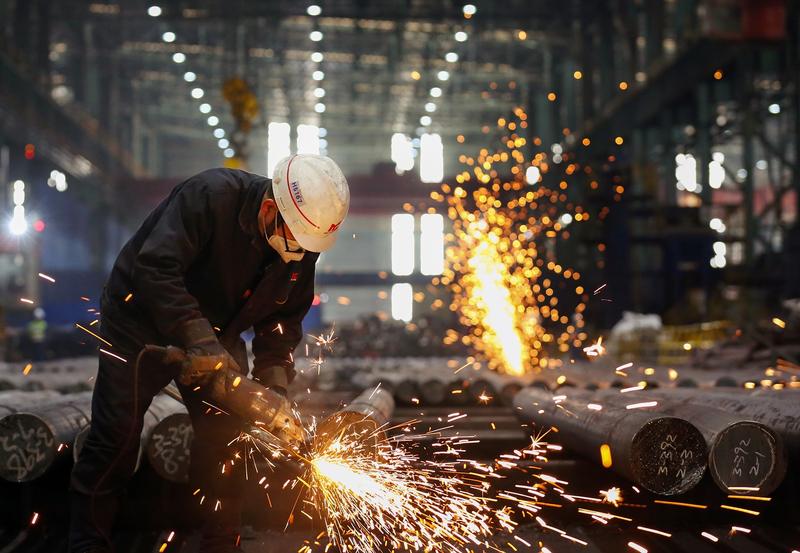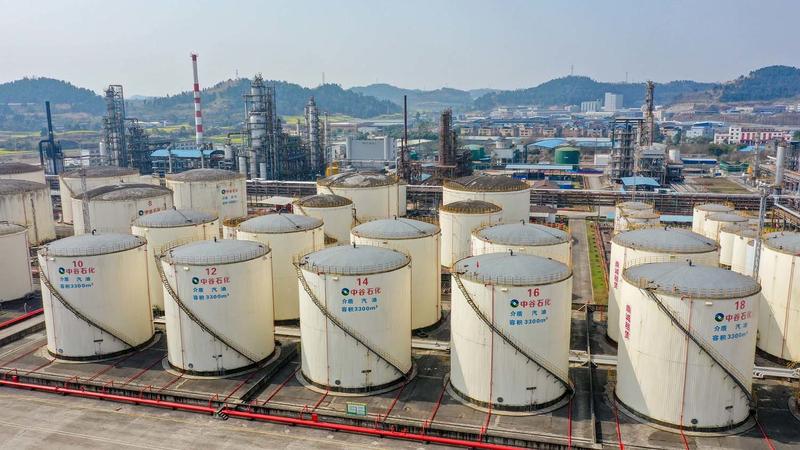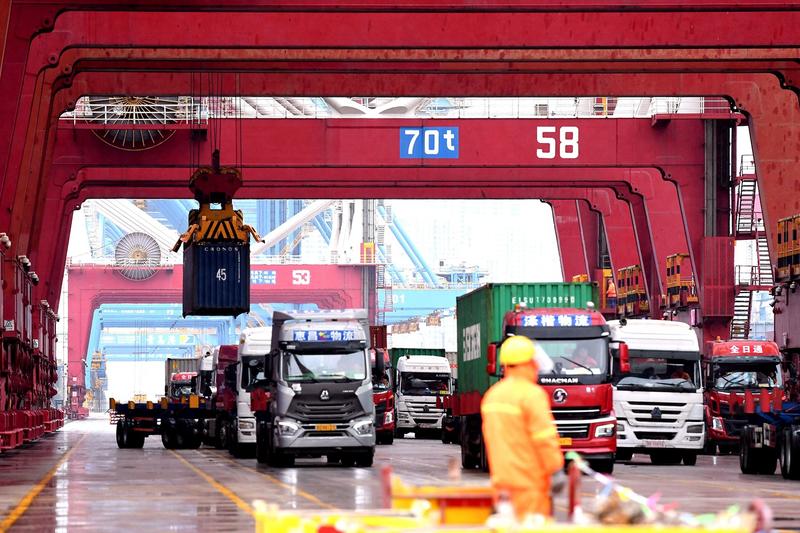Commodity price surge stirs debate on inflation, growth, fiscal and monetary policies
 A worker performs finishing work on steel billets at a special steel company in Ma'anshan, Anhui province, on March 30. A number of factors, including strong industry revival, reduction in inventories, higher appetite for risk, depreciation of the US dollar and heightened geopolitical tensions, have combined to push commodity prices higher. (LUO JISHENG / FOR CHINA DAILY)
A worker performs finishing work on steel billets at a special steel company in Ma'anshan, Anhui province, on March 30. A number of factors, including strong industry revival, reduction in inventories, higher appetite for risk, depreciation of the US dollar and heightened geopolitical tensions, have combined to push commodity prices higher. (LUO JISHENG / FOR CHINA DAILY)
Rising commodity prices have spawned a robust economic debate in China, with experts grappling with the age-old conundrum-how to achieve stable growth amid a risk of high inflation even as the industry struggles to remain profitable, and a flurry of adjustments are made to fiscal and monetary policies?
Commodity prices turned runaway last year as major developed countries unveiled liberal liquidity injections and expansionary fiscal policies for economic reopening after the 2020 pandemic impact. The consensus among economists is that strong industry revival, reduction in inventories, higher appetite for risk and depreciation of the US dollar all combined to push commodity prices higher. And now, heightened geopolitical tensions involving Russia and Ukraine have added to the economic turmoil.
There should be more diversified fiscal policies that can integrate government investment and social capital so that traditional manufacturing companies can be more competitive.
Yang Zhiyong, deputy director of the National Academy of Economic Strategy
Rising raw material prices may push up companies' costs. They either have to absorb such rising costs and settle for lower profits or raise product prices to remain profitable and grow. If they raise prices of their products or services, it may have an impact on downstream consumption, aggravate inflation and crimp the global economic recovery, experts said.
Exporters have already felt the pressure. Since March 17, more than 20 leading Chinese papermakers, including industry giant Shandong Chenming Paper Holdings Ltd and Shandong Sun Paper Co Ltd, have announced they will raise paper prices by 100 yuan ($15.7) to 300 yuan per metric ton to combat soaring raw material and energy prices.
ALSO READ: Direct subsidies right anti-outbreak prescription for micro, small firms
Likewise, heating, ventilation and air-conditioning companies best represented by Midea, Haier and Daikin announced they will raise their product prices by 8 percent to 10 percent in China from March 16. The surging prices of commodities like copper, iron and aluminum, whose negative impact has been amplified by the lingering COVID-19 pandemic, have left these companies with no better choice.
Styrene, which is extracted from oil, is the major raw material used at resin processing enterprises. Li Dajun, general manager of Zhejiang province-based Pure Resin Co Ltd, said the styrene price has jumped from 7,000 yuan to 12,000 yuan per ton over the past few months. Therefore, up to 80 percent of the company's costs have been used to acquire the raw material, affecting production and delivery.
 A view of the petroleum refinery facility of Sichuan Shengma Chemical Industry Co in Daying county, Sichuan province, on March 4. (LIU CHANGSONG / FOR CHINA DAILY)
A view of the petroleum refinery facility of Sichuan Shengma Chemical Industry Co in Daying county, Sichuan province, on March 4. (LIU CHANGSONG / FOR CHINA DAILY)
The textile industry is not immune. Xu Xianyou, an account manager of Jiangsu High Hope Textile Import and Export Co Ltd, said orders of the company have been significantly contracting due to unstable raw material prices.
"Usually, garment companies will place larger orders to textile makers for the designs that are better received among consumers. It is the most economical and efficient way for garment companies. But garment companies have cut their orders this year. And yet, our company's headcount remains unchanged and so do people's working hours. As a result, our costs have increased," Xu said.
The good news is, the central government has taken remedial action immediately.
ALSO READ: Nascent innovation bonds promise to vitalize private firms
During an executive meeting of the State Council, China's Cabinet, chaired by Premier Li Keqiang on March 21, the central government announced it will refund around 1 trillion yuan worth of value-added tax credits, which is nearly two-thirds of total VAT credit refunds this year, to micro and small enterprises and self-employed households as general VAT payers across all sectors. The purpose is to help market entities weather the difficulties, stabilize market expectations and ensure employment.
Liu Kun, China's finance minister, said in late February that the government will carry out tax and fee cuts of a more sizable scale this year, hoping to generate a greater sense of gains for market players.
The National Development and Reform Commission and 11 other central government departments released a policy document on Feb 18 to promote steady growth in the industrial sector, reiterating the goal of stabilizing the overall economy. More financial help will be rendered to traditional export companies, cross-border e-commerce platforms and logistics service providers to set up overseas warehouses. Local governments as well as import and export chambers of commerce will help small and medium-sized enterprises to seek direct contacts with shipping companies, according to the document.
Amid all this, everyone concerned is keen to know: Will the People's Bank of China, the country's central bank, change its monetary policy to address mounting difficulties so that China can successfully attain the 5.5 percent GDP growth target this year?
Zhu Haibin, JP Morgan's chief China economist, said the rising global commodity prices will intensify the inflationary pressure facing China. But the pressure is unlikely to be massive enough to significantly restrict the country's macroeconomic policy space.
ALSO READ: China's private firms get more loan support in 2021
China's factory-gate inflation will abate by a slower slope because of the spike in commodity prices, said Zhu, who has raised the forecast for China's annual producer price index growth by 0.8 percentage point to 5.4 percent.
Consumer inflation will also be affected, but only in a moderate way. Zhu said he expects China's annual CPI growth to come in at 1.7 percent, higher than 0.9 percent last year and still well below the government's target of around 3 percent.
The overall stable consumer inflation will allow the PBOC to ramp up support for the Chinese economy, by way of cutting both the interest rate of its medium-term lending facility, a key policy rate known as MLF, by 10 basis points and the reserve requirement ratio by 50 basis points in the coming months.
Such measures will be necessary to achieve this year's GDP growth target of around 5.5 percent, given the multiple challenges posed by a real estate slowdown, higher import costs and downside risks of net exports, Zhu said.
 Trucks line up at a foreign trade container terminal of Qingdao Port in Shandong province on March 17. China will offer more financial help to traditional exporters. (YU FANGPING / FOR CHINA DAILY)
Trucks line up at a foreign trade container terminal of Qingdao Port in Shandong province on March 17. China will offer more financial help to traditional exporters. (YU FANGPING / FOR CHINA DAILY)
Lu Ting, Nomura's chief China economist, said a spike in commodity prices amid geopolitical tensions may influence China's economy mainly through three channels-higher inflationary pressure, narrower trade surplus and marginal depreciation pressure on the Chinese yuan.
As a major importer of raw materials, China may have to pay more for imports due to soaring international energy and food prices, which could shrink the country's trade surplus and weaken the country's currency slightly, Lu said.
Also, rising global oil and gas prices could sustain industrial goods prices relatively high in China, dampening the willingness of companies to invest and eroding the effectiveness of macroeconomic policy in expanding domestic demand, he said.
China's consumer inflation faces upward risks as well, but the possibility of the country's CPI growth surpassing the government's annual target of around 3 percent remains fairly low in the coming months, Lu said.
READ MORE: Firms can survive, thrive in outbreaks
A potentially higher price level could put the PBOC in a dilemma to some degree, Lu said. On the one hand, the central bank may need to ease its policy to stem price rises from impairing aggregate demand in the economy. On the other hand, it may need to keep the monetary condition stable to avoid amplifying inflationary pressure.
The PBOC may strike a delicate balance by launching moderate easing measures, said Lu, who forecast a cut in the MLF interest rate by 10 basis points sometime this month and a reduction in the reserve requirement ratio by 50 basis points over the next couple of months.
While the market expected that the PBOC will announce in March a lower loan prime rate, the benchmark lending rate, the one-year LPR and the five-year LPR remained unchanged from the data in February.
The central bank's stance on monetary policy has so far remained unchanged. The monetary policy will remain prudent and flexible in general. Meanwhile, sufficient support will be rendered to micro and small enterprises as part of the efforts to support the real economy.
Iris Pang, chief China economist at Dutch bank ING, does not expect the rising energy prices to change the PBOC's future decisions to cut interest rates.
Given sluggish domestic demand, especially on the consumption front, higher energy prices can hardly translate into broad-based inflation and therefore may not impede the PBOC from cutting interest rates, Pang said.
According to her, the PBOC may front-load interest rate cuts in the first half of the year to boost consumption and investment, potentially sending the one-year LPR to 3.2 percent by the end of the year from 3.7 percent at present.
But Su Jian, a professor with the School of Economics at Peking University, stressed that fluctuating raw material prices should receive more attention. Manufacturing companies' investment confidence was once shaken in the first half of 2021 due to rapidly rising commodity prices. There should be more professional analysis of the future commodity price trend and policy guidance so that manufacturing companies' willingness to invest can be buoyed.
Traditional manufacturing companies now face tremendous challenges, and technology upgrading is the only way to survive, said Yang Zhiyong, deputy director of the National Academy of Economic Strategy. But strong government support is crucial so that companies can invest boldly to upgrade their equipment and technologies.
"There should be more diversified fiscal policies that can integrate government investment and social capital so that traditional manufacturing companies can be more competitive," he said.
Contact the writers at shijing@chinadaily.com.cn


